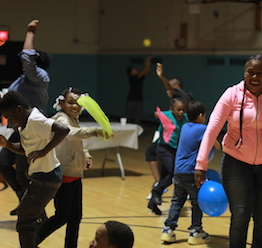Engagement Events: Dance Theater Etcetera
Navigation Menu
- Advocacy Resources
- Artist’s Legacy Toolkit
- Audience Engagement Strategies
- Building Audiences for the Arts: Research and Resources
- Coronavirus Resources
- Dance/USA Fellowships
- Dance/USA Task Force on Dancer Health
- Equitable Contracting Resources
- Funding Resources
- Harassment in the Workplace Resources
- Jobs, Auditions, & Internships
- Key Advocacy Issues
- Music and Choreography Resources
- Mentorship Program: Dance/USA Institute for Leadership Training
- Request a Peer Consultation Letter
- Scheduling Congressional Visits
-
 Organization Name: Dance Theatre Etcetera
Organization Name: Dance Theatre Etcetera
Department Submitting Recipe: NA
City: Brooklyn
Program Name: We don’t have a specific name for our audience engagement programs. Each event had its own name, i.e. Red Hook: Move It for our participatory dance parties and pre-view performances, DTE Community Dinner, DTE Community Cook Out and Dance Party, Dance Workshop for Seniors, etc.
Time of Program: Various times. Mostly mornings and evenings.
Program Length: Each activity had a specific duration: dinners and dance parties 2 hours, workshops 1-1.5 hours.
Goal: DTE’s goals for the project are as follows: • Develop and test new models for audience engagement • Build an expanded network of community relationships • Offer employment opportunities and job training for low income residents • Heighten DTE’s profile in Red Hook, citywide, and nationally as a cultural innovator • Support artists in developing and testing models for community engagement that they can bring to other places; support emerging local artists of color
Time of Year Offered: Fall and Spring
Program Description:
DTE produces two major dance events annually. Leading up to these events, depending on available resources, we schedule activities that bring audiences and artists together. They can take the form of workshops for our senior citizens, for participants in a support group for single parents, the staff of our local community justice center, community leaders dinners, participatory DJ dance parties with previews of artists’ works in progress or short performances at established community events such as Night Out Against Crime or the annual Old Timers Day that is time for reuniting friends and neighbors
Number of Participants: As few as 5 and as many as 150.
Target Audience: The target audience is Red Hook’s 8,250 predominantly low-income residents who live in the Red Hook Houses, Brooklyn’s largest public housing development, who are 48% African American, 48% Hispanic/Latino, 22% Asian and 2% other. In addition, Red Hook is in the midst of accelerating gentrification, with an increasing sense of alienation and psychological displacement among long-term residents, as well as a growing fragmentation of the community. DTE’s programming is specifically targeted to Red Hook’s low income residents of color, but also appeals to more affluent newcomers, creating opportunities to bridge these two populations who live within blocks of each other – all the more urgent as climate change-driven storms require community-wide collaboration on resiliency planning.
Is the program for kids? Most of our activities take place out of school time. We have offered workshops at afterschool sites. Some activities offer instruction and self-expression. Some are are more social occasions.
Private/Public Public
Nature of Audience Engagement: Audience may be guests at a dinner. They eat, talk and take part in facilitated activities like story sharing or dance activities. Other activities are workshop. Participants listen to artists, move, and share stories. At our participatory dance parties audience dance, eat, talk, play games and watch dance performances. All in person.
Location: In our facility, local schools, community centers, partner non-profit’s spaces, parks and senior centers.
How Many Staff: We had a Project Manager ( our Education Director) who was assisted by 2 part time Dance Ambassadors as well as interns. Additional DTE staff assisted as well.
Program Cost: We had a Project Manager ( our Education Director) who was assisted by 2 part time Dance Ambassadors as well as interns. Additional DTE staff assisted as well.
Marketing for Program: We rely on locally hired Dance Ambassadors, our own networks and our local non-profit partners to market these events. Our Marketing Manager makes flyers and creates event pages on Facebook.
Cost for Program Participants: Free
Attendance To Date: 1500 in pre-performance audience engagement; 3505 attendance at Red Hook Fest, 300 attendance at Dance on the Greenway
Past Iterations: 16 Audience Engagement Activities
What works? Music, food and interactive activities are always useful. Also making events “family friendly” by having activities that kept kids engaged helped bring parents out. Our dinners that included facilitated conversations and interactive activities worked better than those left largely unfacilitated. Picking the space and understanding the politics of each space is important. We conducted activities in spaces that our target audience frequent and feel welcome and comfortable in.
What doesn’t work? It was important to our program to hire locally for help with outreach. While our Dance Ambassadors did have extensive networks within public housing residents, they were not always effective at utilizing them. More support and training would have been useful to make them more effective, as well as replacing staff who, for whatever reason, were not able to do their assigned responsibilities. This is challenging in a tight knit community.
Performances Where Offered: We offer some of these pre-event activities before major dance presenting events depending on available resources.
Past Research on Program: We used the survey developed with Surale Phillips. It was useful in that it helped us understand how the organization is perceived by our target audience.
Continuing Program? Yes, we have revamped our fall event and it will mirror or interactive dance party events we developed through our Engaging Dance Audiences project with presentations of live professional dance performances and DJ dance party. We have seen the benefit in bringing added value in the form of live dance performances to existing community events.
Resources & Links:
A short video about DTE’s audience engagement activities leading up to our Dance on
